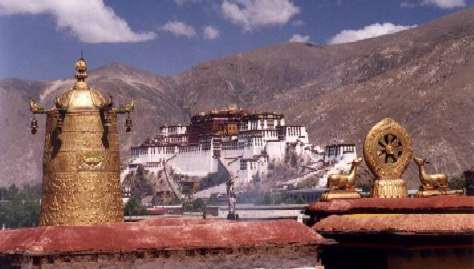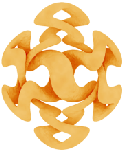
BUDDHISM IN TIBET
THE INITIAL INTRODUCTION
DECLINE AND REVIVALBuddhism almost disappeared after 842 when King Lang Dharma violently persecuted Buddhism. After this, for a long time there were no ordinations and no central religious authority in Tibet. Instead, the original Bon religion prevailed. In 978, with the introduction of several Indian Pandits and Tibetan monks studying in India, Buddhism revived, with the help of king Yeshe O. A real revival occurred after 1042, when Atisha-di-Pankhara (or Lama Atisha) put Tibetans "back on the right track". He presented the Buddhist philosophy in a very clear and condensed manner, which became the basis for philosophical teachings in most Tibetan traditions (known as Lam Rim in the Gelugpa school and Lam Dre in the Sakya school). After Atisha, the influence from Indian teachers was limited. Atisha's main disciple was the layman Dromtönpa, who founded the Kadam-tradition. This tradition does not exist in that form anymore, but strongly influenced the later schools of Kargyu, Sakya and especially Gelug. Note that Tibetan teachers like His Holiness the Dalai Lama
insist that Tibetan Buddhism these days still carefully reflects the Buddhism
as was present in India around the 11th century. He also rejects the term
Lamaism, as it suggests as if the Tibetan teachers have developed their own
form of Buddhism. NYINGMA The Nyingma school is more or less a continuation of the
initially introduced Buddhism by the Indian Pandit Padmasambhava (Guru Rinpoche
- see image on the right). Historic information of Padmasambhava is generally
shrouded in myths, (he is said to have lived for 3,600 in India prior to coming
to Tibet), but he came to Tibet in 817 at the invitation of King Trisong Detsen.
KADAMNot existing as such anymore, but it was the main reformation school after revival of Buddhism in the 11th century by Atisha di Pankara from India (c. 982-1052, see the image on the left) and Dromtonpa as his Tibetan disciple. Atisha combined two lineages: from Manjushri via Nagarjuna (emphasising emptiness) and from Maitreya via Asangha (emphasising compassion). Atisha'svery influential brief text 'A lamp for the path to full awakening' formed the basis of the later Gelug presentation of Lam Rim and the Sakya psentation of Lam Dre. KARGYU
For a Kargyu lineage see this page of the kargyu.org website.
|
 |
Among the early Tibetan masters of what later became the Jonang tradition was Yumo Mikyo Dorje, an 11th century yogi and student of the great Kashmiri scholar Somanatha. In the 13th century, Kunpang Tukje Tsondru established a main monastery at Jomonang in South Central Tibet, thus giving rise to the name Jonang.
The Jonang tradition is the primary holder of the Dro transmission and practice lineage of the Kalachakra Tantra, the Six Yogas of the Kalachakra completion stage, and the Zhentong (gzhan stong) or "emptiness of other" view.
In the 17th century, during the rule of Fifth Dalai Lama, the Gelug persecuted the Jonang and forcibly closed or converted the Jonang monasteries in Central Tibet for mainly political reasons. After this persecution, the Jonang were thought to have become extinct.
Recently, a number of remote Jonang monasteries were "re-discovered". In these monasteries the Jonang tradition continues its studies and practices uninterruptedly up to the present. Nowadays, His Holiness the 14th Dalai Lama has repeatedly expressed his admiration for the preservation of the Jonang tradition and their Kalachakra practice.
WORDS OF TRUTH
By His Holiness the Dalai Lama
Honoring and Invoking the Great Compassion of the Three Jewels; the Buddha, the Teachings, and the Spiritual Community
O Buddhas, Bodhisattvas, and disciples of the past, present, and future:
Having remarkable qualities Immeasurably vast as the ocean,
Who regard all helpless sentient beings as your only child;
Please consider the truth of my anguished pleas.Buddha's full teachings dispel the pain of worldly existence and self-oriented peace;
May they flourish, spreading prosperity and happiness through- out this spacious world.
O holders of the Dharma: scholars and realized practitioners;
May your ten fold virtuous practice prevail.Humble sentient beings, tormented by sufferings without cease,
Completely suppressed by seemingly endless and terribly intense, negative deeds,
May all their fears from unbearable war, famine, and disease be pacified,
To freely breathe an ocean of happiness and well-being.And particularly the pious people of the Land of Snows who, through various means,
Are mercilessly destroyed by barbaric hordes on the side of darkness,
Kindly let the power of your compassion arise,
To quickly stem the flow of blood and tears.Those unrelentingly cruel ones, objects of compassion,
Maddened by delusion's evils, wantonly destroy themselves and others;
May they achieve the eye of wisdom, knowing what must be done and undone,
And abide in the glory of friendship and love.May this heartfelt wish of total freedom for all Tibet,
Which has been awaited for a long time, be spontaneously fulfilled;
Please grant soon the good fortune to enjoy
The happy celebration of spiritual with temporal rule.O protector Chenrezig, compassionately care
For those who have undergone myriad hardships,
Completely sacrificing their most cherished lives, bodies, and wealth,
For the sake of the teachings, practitioners, people, and nation.Thus, the protector Chenrezig made vast prayers
Before the Buddhas and Bodhisativas
To fully embrace the Land of Snows;
May the good results of these prayers now quickly appear.By the profound interdependence of emptiness and relative forms,
Together with the force of great compassion in the Three Jewels and their Words of Truth,
And through the power of the infallible law of actions and their fruits,
May this truthful prayer be unhindered and quickly fulfilled.
This prayer, Words of Truth, was composed by His Holiness Tenzin Gyatso, the Fourteenth Dalai Lama of Tibet, on 29 September 1960 at his temporary headquarters in the Swarg Ashram at Dharamsala, Kangra District, Himachal State, India. This prayer for restoring peace, the Buddhist teachings, and the culture and self-determination of the Tibetan people in their homeland was written after repeated requests by Tibetan government officials along with the unanimous consensus of the monastic and lay communities.
OPINION OF THE CURRENT SITUATION IN TIBET (occupied by China)
"They were conquerors, and for that you want only brute force - nothing to boast of, when you have it, since your strength is just an accident arising from the weakness of others.
They grabbed what they could get for the sake of what was to be got.
It was just a robbery with violence, aggravated murder on a great scale, and men going at it blind - as is very proper for those who tackle darkness.
The conquest of the earth, which mostly means the taking it away from those who have a different complexion or slightly flatter noses than ourselves, is not a pretty thing when you look into it too much."
Heart of Darkness by Joseph Conrad
LINKS
Who better than His Holiness the Dalai Lama....A
Survey of the Paths of Tibetan Buddhism.
The authoritative source for Tibetan matters, including the Buddhist traditions
is found on the website of the Tibetan Government
in exile .
If you want to help, see the website
of the Tibetan Relief Fund of the UK.
A good summary of the Tibetan Buddhist history is found on this page of Simhanada
Much information on Tibet can be found in this FAQ sheet of Tibet.
Last updated: September 10, 2021
 Probably Buddhism was first introduced to Tibet in 173 CE
during the reign of the 28th Yarlung king Lha Thothori Nyantsen, but had apparently
no impact.
Probably Buddhism was first introduced to Tibet in 173 CE
during the reign of the 28th Yarlung king Lha Thothori Nyantsen, but had apparently
no impact.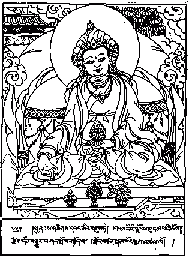 The
33rd King of Tibet, Song Tsen Gampo (born 617) had the book translated and
married two Buddhist princesses. With this, one can say that Buddhism was
first really introduced to Tibet as a practice.
The
33rd King of Tibet, Song Tsen Gampo (born 617) had the book translated and
married two Buddhist princesses. With this, one can say that Buddhism was
first really introduced to Tibet as a practice. 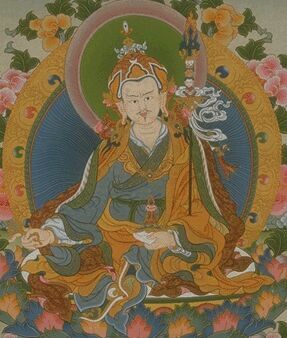
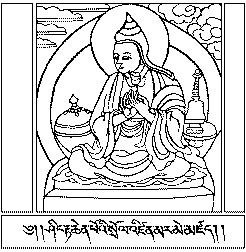
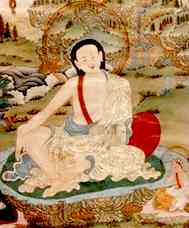 This tradition started with the Tibetans Marpa Chökyi
and Khyungpo Nyaljor, in the 11th. century, who had Tilopa (988-1069) and
his disciple Naropa (1016 - 1100) as Indian masters.
This tradition started with the Tibetans Marpa Chökyi
and Khyungpo Nyaljor, in the 11th. century, who had Tilopa (988-1069) and
his disciple Naropa (1016 - 1100) as Indian masters. 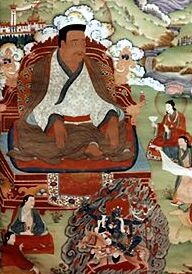
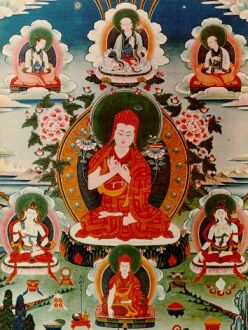
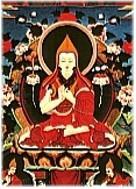 The
Gelugs (also called the yellow hats) tradition was founded by Tibetan teacher Je Tsongkhapa
(1357-1419 - see image on the left). The basis is formed by the old Kadam
lineage, but it in fact includes all other Tibetan traditions. For example;
Tsongkhapa's main teacher was the Sakya teacher Rendawa.
The
Gelugs (also called the yellow hats) tradition was founded by Tibetan teacher Je Tsongkhapa
(1357-1419 - see image on the left). The basis is formed by the old Kadam
lineage, but it in fact includes all other Tibetan traditions. For example;
Tsongkhapa's main teacher was the Sakya teacher Rendawa. 